Wetlands Conservation on the Flathead Indian Reservation
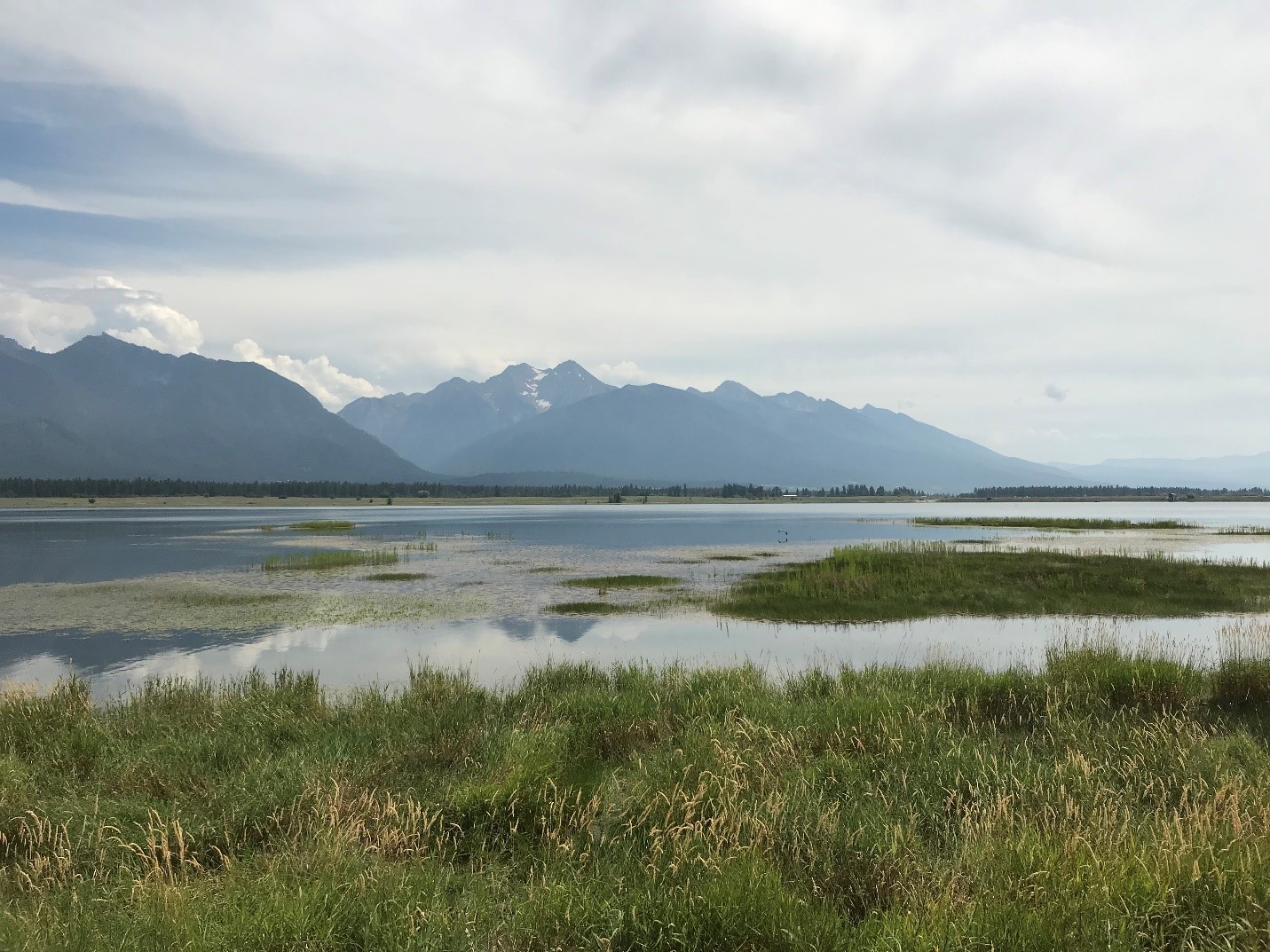 Kicking Horse Reservoir. photo credit: Tabitha Espinoza
Kicking Horse Reservoir. photo credit: Tabitha Espinoza
|
According to the Séliš-Ql̓ispé Culture Committee, “Séliš and Ql̓ispé elders have told us that we must respect and take care of our lands, waters, and air, and the plants and animals that depend upon them. These are the priceless gifts that make our lives possible. They have sustained us physically and spiritually through our thousands of years of continuing presence in our homelands. We look to them not only for food and medicine and clothing and shelter, but also for spiritual help, for guidance and direction. Our relationship of respect with our environment is an obligation handed down to us from those who came before. It is also our responsibility to the generations yet to come. It stands at the heart of our culture — of who we are as a people. The naslex͏ʷ, the wetlands, are places of special abundance in many of the things that have nourished and sustained us for millennia. There we find many of our cherished foods and medicines, such as ṃsáwyeʔ (edible valerian) and ṇt̓e (gooseberry). There we gather materials for mats and coverings from p̓išɫp (cattail) and tik͏ʷt̓n (bulrush or tule), and plants used for taking care of our babies, such as snq͏ʷspú (sphagnum moss). The naslex͏ʷ provide homes for many important animals, including splq͏ʷa (turtle) and ɫmɫam̓áye (frog) and ččl̓ex͏ʷ (muskrat). They are the nesting areas for many birds, such as smóq̓͏ʷeʔ (great blue heron) and smat̓qʷul̓ (black-crowned night heron) and x̣wítx̣͏ʷo (American bittern), and many types of sesƛ̓x͏ʷúm̓ (ducks). In our traditional ways, we hold deep knowledge of all these plants and animals.
We must do all that we can to protect wetlands, and wherever possible, to restore those that have been damaged or destroyed. In this way, we are carrying on a central part of the cultural ways handed down to us from the ancestors: our sacred relationships of respect with all living things.” |
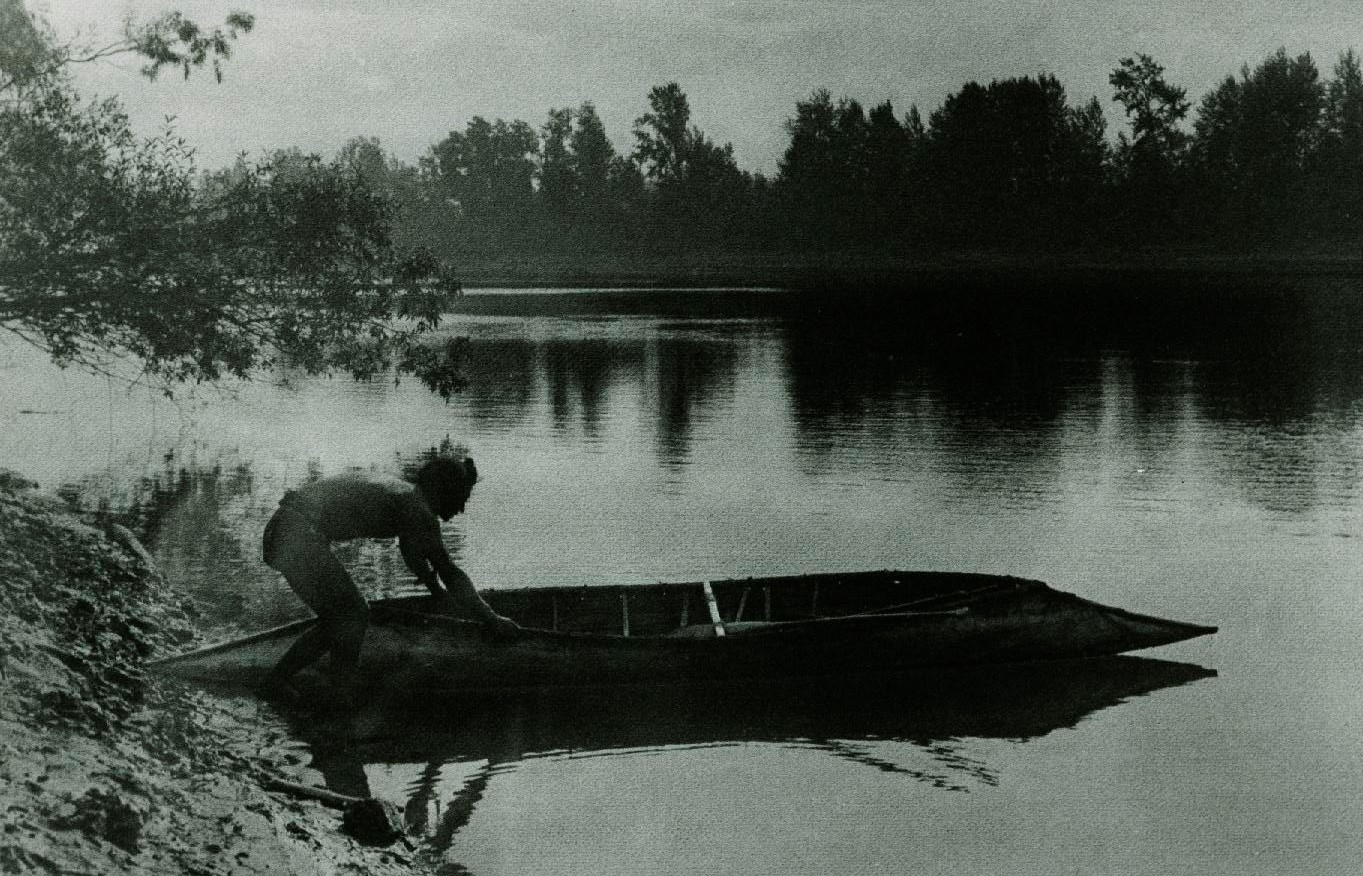 Caption: Canoeing the Kootenai River in a yaqsuʾmiⱡ (Kootenai for sturgeon-nose canoe)
Caption: Canoeing the Kootenai River in a yaqsuʾmiⱡ (Kootenai for sturgeon-nose canoe)
A statement from Vernon Finley, Kootenai expert
“As you might know, the name “Kootenai” is actually a northern Dine word that means “River people”. It comes from early explorers’ movement west in what is now Alberta, Canada. When they contacted and traded with the Northern Dine living on the northern plains they asked who the neighboring tribe was to the west of them in the mountains. The Northern Dine name for us was Kootenai.
Much of the traditional lifestyle of the Kootenai people centers on water. The “Crown of the Continent” is in the heart of Kootenai territory. The sturgeon nose canoe that is a cultural hallmark of the Kootenai people is indicative of our relationship with the water. The canoe design and construction comes from the pre-human period often referred to in the Coyote Stories and is symbolic of the spiritual relationship the people have with water. The rivers and waterways were the highways of the people prior to the arrival of the horse. The highway or road or trail a person travels is a metaphor for their journey in life so you can see why maintaining calm, clean waterways has a direct impact on life itself. Wetlands produce much of the foods and medicines that are important for the survival of the Kootenai people. So not only do the people have a historic spiritual cultural connection to wetlands they also have a physical subsistence connection as well.”
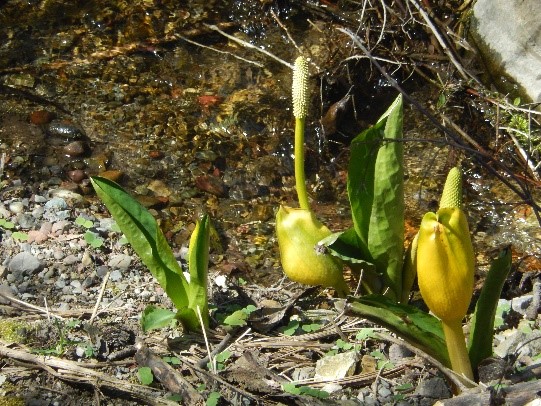 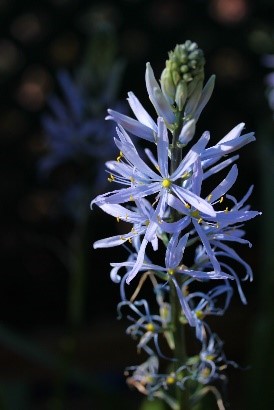 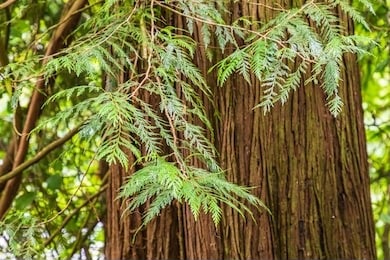 |
| Left to right: Skunk Cabbage (credit: Tabitha Espinoza), Blue Camas (credit: PxHere), Western Red Cedar (credit: Shuttestock) |
Séliš, Ksanka, and Ql̓ispé peoples have depended on diverse wetland resources in this region for generations. Today, Natives and non-Natives alike cherish the wetlands of the Flathead Indian Reservation for the opportunities they provide in fishing, wildlife watching, hunting, gathering, birding, photography, and more.
Wetland habitats are extremely diverse and difficult to define. They contain one or more of the following three components:
- Hydrophytic plants that are adapted to thrive in wet conditions.
- Soils that have been chemically altered due to periodic or continual saturation.
- Hydrology, or simply water, that sits at or near the soil surface for greater than two weeks during the growing season.
A wide variety of wetland types can be found within the Reservation, including potholes, ponds, wet meadows, side-hill seeps, fens, lake fringe and riverine floodplains.
The Many Values of Wetlands
Wetlands benefit people and wildlife in many ways:
- The majority of Montana’s wildlife species rely on wetlands for food, cover or water.
- Wetlands act as sponges that store water during spring and early summer runoff, thus reducing downstream flooding.
- The storage capability of wetlands helps to recharge ground water and increases much needed late summer stream flows.
- Wetlands filter water of harmful pollutants, thus improving the quality of drinking water for communities living lower in the watershed.
- These moist environments provide natural barriers for wildfire.
Threats to Wetlands
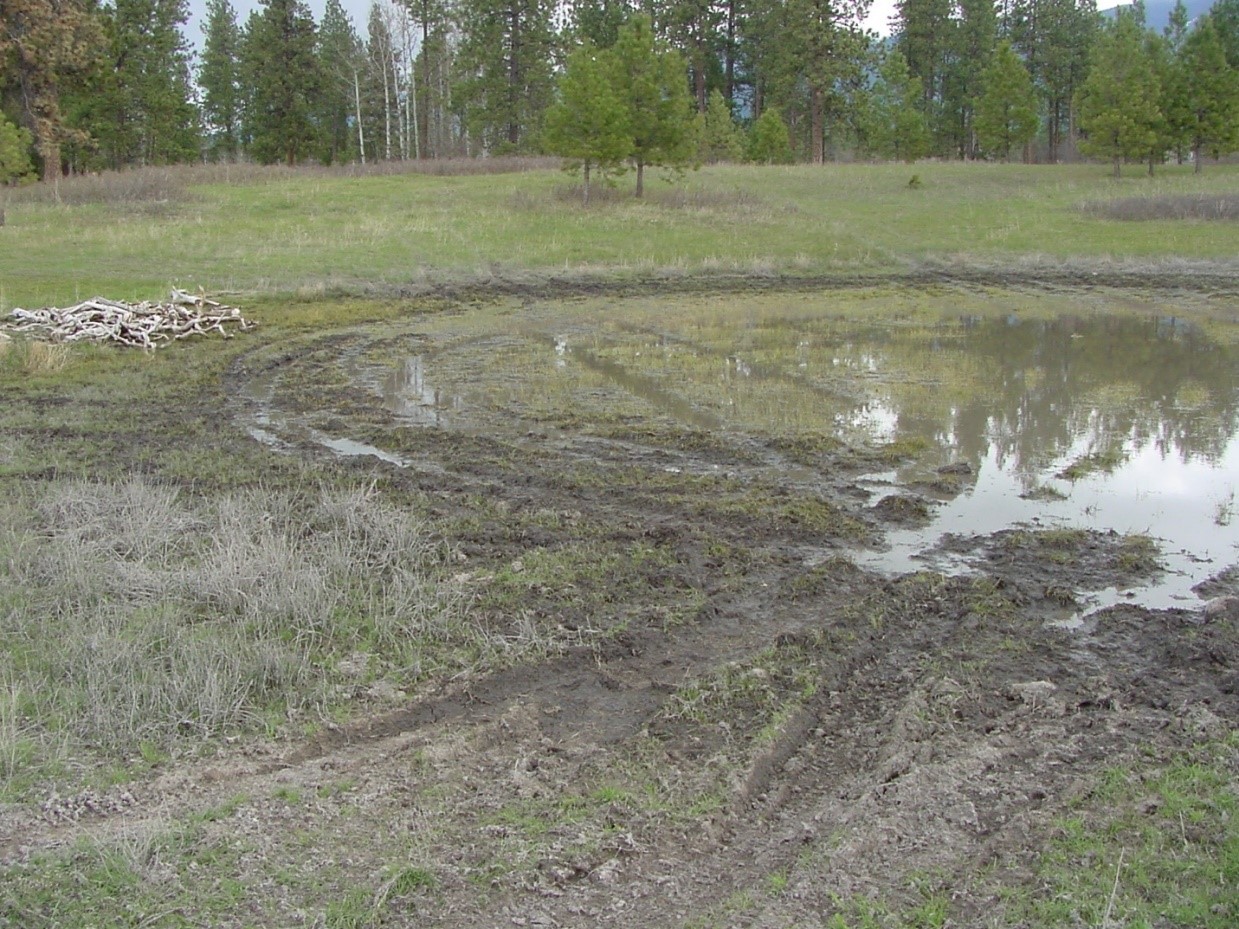 |
| Illegal motorized off-road activity in and around wetlands degrades wildlife habitat and impacts water quality for people, fish and livestock. This photo depicts severely degraded birthing habitat for salamanders and toads due to off-road vehicle use. Photo credit: Janene Lichtenberg |
Wetlands are often misunderstood and many have been intentionally or unintentionally impacted or destroyed. Studies have estimated that twenty-two states within the US have lost over 50% of their wetland area within the past 250 years. California is shown to have the highest loss (91%). Montana has lost 27% of its original wetland acreage. Many of the remaining wetlands have been degraded and lost their functional value. The reasons for these losses are complex and numerous:
- Beaver were the original wetland engineers. Due to widespread trapping during the fur trade, millions of beaver were removed from the landscape, resulting in widespread loss of wetlands and preventing new wetlands from being created.
- Many wetlands have been drained or filled for conversion to agriculture fields.
- Dams and impoundments often flood out wetlands.
- Cattle grazing in wetland areas results in trampling of vegetation and creates tracks in the mud that provide breeding habitat for mosquitoes.
- Wetlands across the country have been drained and filled to make room for commercial and residential development.
- Several exotic plant species have been intentionally or unintentionally introduced into wetland areas, reducing habitat quality and functions.
CSKT’s Wetland Conservation Program
The Wetlands Conservation Program serves many purposes. First and foremost, it maintains CSKT’s Wetland Conservation Plan (1999), with the goal of ‘no net loss’ of wetland acreage or function. To achieve this goal, the program provides:
- Assessment and monitoring of wetland functions
- Wetland inventory mapping
- Aquatic Invasive Species mapping
- Outreach and education
- Professional development opportunities for staff
- Technical assistance and support
 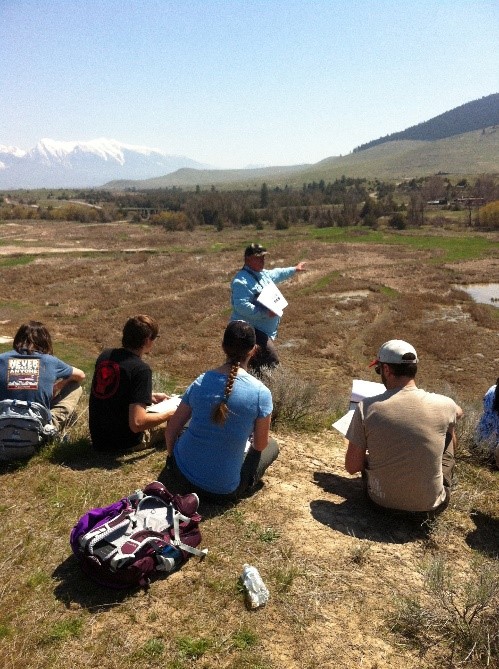 |
| Left: Example of the National Wetland Inventory mapping. Crow Creek is shown in the upper portion and potholes in the Kicking Horse area. Right: a training opportunity to aid in the professional development for CSKT staff and SKC students (photo credit: Dennis Lichtenberg) |
How YOU can protect our wetlands
- Preserve or plant vegetated buffers around wetlands and other aquatic environments on your property.
- Follow label directions when applying pesticides or fertilizers. Under national law (FIFRA), if label directions are not followed, it is a considered a violation and regulatory action can be taken.
- Dispose of used oil, antifreeze, paints and other household chemicals properly—not in storm sewers or drains.
Don’t dump trash or yard waste in or around wetlands and streams.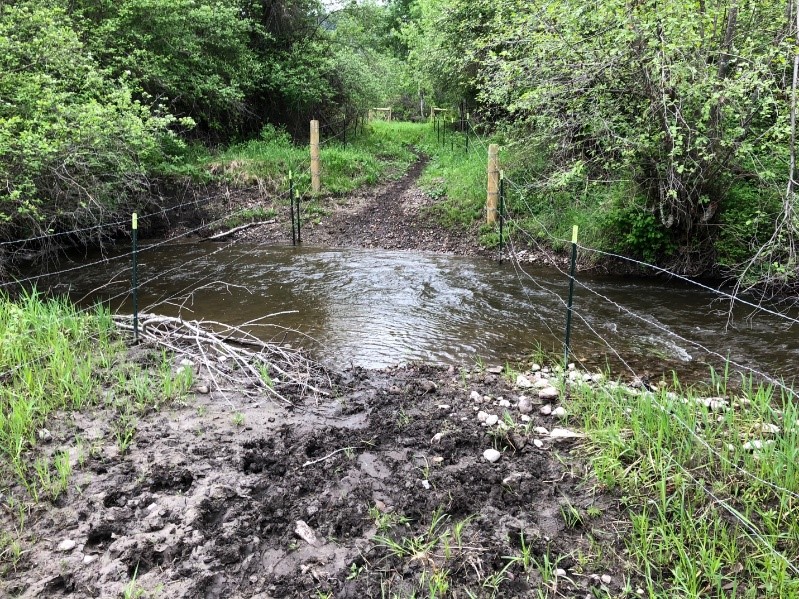
Cattle exclusion fencing with watering gaps allow livestock to access water in limited areas and preserves the excluded area. This keeps streams, wetlands and livestock healthy.Photo credit: Chauncey Means
- Educate yourself about Montana’s aquatic invasive species and animals.
- Keep motorized vehicles on the roads and out of wetlands, streams and rivers to prevent erosion, sedimentation and the spread of noxious weeds.
- Protect waterfowl and other birds by using non-lead alternatives for fishing sinkers and ammunition.
- Keep livestock and wetlands healthy by allowing access only through watering gaps or off-site water sources such as water troughs and tanks.
- If work needs to take place in a stream or wetland please check with the CSKT Shoreline Protection Program. Visit their webpage for contact information and permitting requirements.
- Report suspicious dredge and fill activities, as well as other environmental degradation issues on this on-line form, which can be found on the CSKT Natural Resources Department homepage.
- Take time to enjoy our wetland and aquatic resources!
